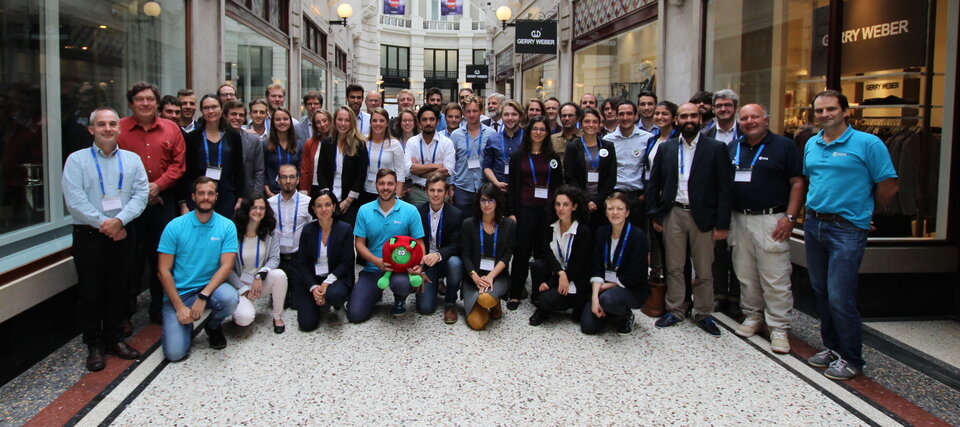Selection of the Fly Your Thesis! 2017 teams
Six teams have been selected for an opportunity to fly their experiment during ESA Education’s Fly Your Thesis! ‘hands-on’ programme for university students. The selection was made by the Fly Your Thesis! Selection Board which is made up of members of ESA’s Education and Human Spaceflight & Robotic Exploration offices, the European Low Gravity Association (ELGRA), and Novespace.
Last summer, ESA’s Education office released an announcement of opportunity on its website calling for experiment proposals to be flown on the popular parabolic flight campaign. The competition was open to teams interested in developing an experiment in a broad array of scientific or technological disciplines which would be affected by gravity. A total of 22 teams submitted experiment proposals, and after a preliminary selection phase, 10 of these teams were asked to present their ideas in detail to the Selection Board during a face-to-face meeting.
The ten student teams came to the Netherlands for two days. On the first day they were treated to a broad overview of ESA and ESA Education activities, followed by presentations by ESA’s parabolic flight campaign manager, ELGRA, and Novespace.
On the second day, the students had to convince the Selection Board to select their experiment for flight. The Board asked the students pertinent questions regarding the science, engineering, and feasibility behind each proposed student project.
After some lengthy discussions, the Selection Board eventually came to a consensus as to which teams should be invited to develop their experiment for the Fly Your Thesis! campaign in December 2017 at Novespace’s facilities at the Bordeaux Mérignac airport.
The selected teams are:
The Flying Squirrels
The Flying Squirrels team is composed of PhD and MSc students from ISAE SUPAERO/ONERA in France. The experiment consists in testing an innovative system to control the attitude (orientation in space) of small satellites (nanosatellites). The attitude control system is composed of a new configuration of actuators and a new steering law to control nanosatellites, adapted for future space missions.
The SaMBA team
The SaMBA (Spatial, Motor and Body Awareness) research group from the University of Turin’s Psychology Department in Italy studies how our brain handles basic cognitive functions such as spatial, body, and movement awareness. This research group applies different methodologies and combines multiple approaches: neuropsychology, neuroimaging, neurostimulation, psychophysiology, and immersive virtual reality. The aim of their parabolic flight experiment is to investigate the rubber hand illusion (RHI) in differing gravity conditions. It is known that the way we rely on vision and proprioception changes when gravity is different from usual. Replicating the rubber hand illusion on parabolic flights would enable the team to identify how gravity interacts with the integration of different sensory inputs, and thus shapes our body schemes.
VESTAND team
The VESTAND team is comprised of Dutch students from the Erasmus Medical Centre and Delft University of Technology trained in biomedical and engineering sciences.
The team will determine how gravity modulates the vestibular contribution to the perception of self-motion and the ability to stand upright. They will use galvanic vestibular stimulation, a popular research tool to artificially activate the vestibular system (i.e. the balance organ) in human volunteers. The electrical stimulus evokes a perception of motion and postural reflexes during standing balance. The results will reveal the neural computations involved in perception of self-motion and postural control, and may prove useful for future space missions to alien planets (e.g. Mars).
AML Space Group
The AML Space Group is composed of students from the Applied Mechanics and Vibrations Laboratory of the University of Patras (AML/UPAT).
The team will test some space manufacturing concepts by experimenting on UV polymer materials and composites in microgravity provided by a Zero-G flight. Specifically, a series of small polymer specimens and novel inflatable composite tubes will be cured in microgravity, and will be tested in 1g at a later stage.
PACMAN (Position and Attitude Control with MAgnetic Navigation)
The PACMAN team is composed of 6 Italian students from the University of Padova. The PACMAN experiment is a technology demonstrator whose main goal is to develop and validate, in low-gravity conditions, an integrated system for proximity navigation and soft docking based on magnetic interactions, suitable for cooperating small-scale spacecraft.
BrainFly
Team BrainFly is a Dutch team that consists of four Cognitive Neuroscience Master students from different universities in the Netherlands, and is supervised by three researchers with experience in Brain Computer Interfaces (BCI). Their research is aimed towards better understanding the influence of gravitational changes on brain functioning and will especially be focused on the possibility of using BCI technologies in space. BCIs give us the possibility to use brain signals to control applications without any physical interaction.
A long and arduous journey awaits all the students, but the rewards far exceed the efforts, since participation in this programme will help them in years to come, preparing them for their young professional careers.
If interested in parabolic flight opportunities for students, check out ESA’s Education web pages for a new announcement of opportunity early next year. You can also follow the teams’ progress and updates of the Fly Your Thesis! 2017 campaign by visiting the Fly Your Thesis! pages.
For more information contact: FlyYourThesis @ esa.int





